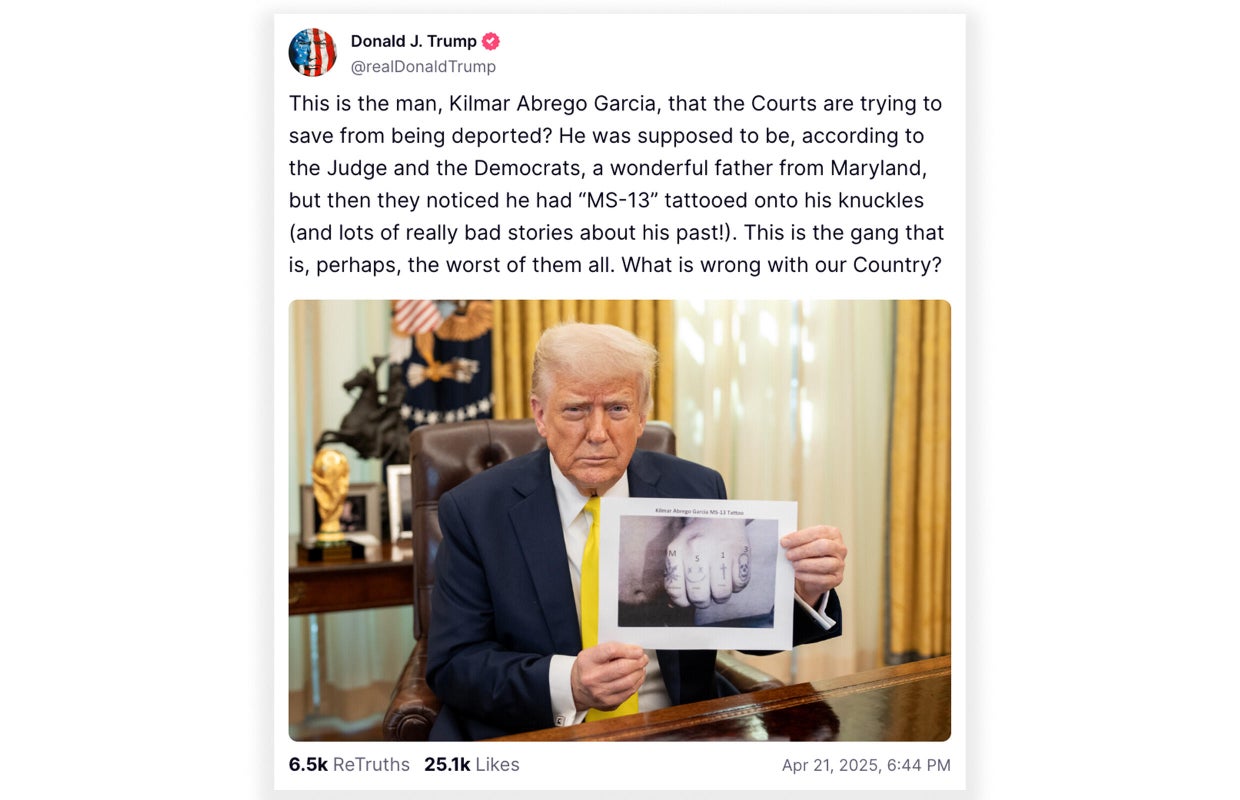President Trump has repeatedly shared an image of Kilmar Abrego Garcia’s finger tattoos in an effort to link the Maryland man, who was mistakenly deported to El Salvador on March 15, to the notorious MS-13 gang.
On Monday, Mr. Trump again shared a photo of Abrego Garcia’s left hand on social media, alleging he “had ‘MS-13’ tattooed onto his knuckles.” The image shows the characters “M,” “S,” “1” and “3” digitally added above Abrego Garcia’s existing tattoos — a leaf, a smiley face, a cross and a skull — along with labels describing each symbol beneath.
Many people online recognized the labels as digitally added, but some alleged they were designed to appear as part of Abrego Garcia’s actual tattoos and accused the Trump administration of trying to mislead the public. The White House has not responded to multiple requests for comment about the image and who added the labels.
The experts and researchers we spoke with acknowledged the tattoos could carry gang-related symbolism, but they said the markings alone are not reliable indicators of membership. They also cast doubt on Trump’s claims that the marijuana leaf represents an “M,” the smiley face “S,” the cross “1” and the skull “3.”
Abrego Garcia has no criminal record and his family says he was never involved with a gang.
He was deported and sent to El Salvador’s notorious mega-prison, designed to hold the most dangerous gang members, before being moved to another facility as his case attracted widespread attention. As legal efforts to bring him back to the U.S. continue, the Trump administration has cited Abrego Garcia’s finger tattoos as evidence of alleged MS-13 affiliation.
Roberto Lovato, an assistant professor at University of Nevada, Las Vegas, whose memoir chronicled growing up in California during MS-13’s early years, said although symbols are “notoriously difficult to interpret,” he does not believe Abrego Garcia’s tattoos are suggestive of MS-13 membership.
Lovato also said current gang members he has spoken to do not believe Abrego Garcia’s tattoos represent MS-13.
Maya Barak, an associate professor of criminal justice studies at the University of Michigan-Dearborn, told CBS News that tattoos such as devil horns, the letters “M” and “S” and the numbers “1” and “3” have been used by MS-13 members. The National Gang Center and FBI both cited variations of “MS,” “13” and devil horns as tattoos associated with MS-13.
A community activist, who spoke on the condition of anonymity for fear of retribution, told CBS News he has worked with gang members for more than 25 years and has never seen a series of finger tattoos like Abrego Garcia’s linked to MS-13.
The Trump administration’s “border czar” Tom Homan told ABC News “you can’t ignore a tattoo” but said people are not being labeled as gang members strictly based on their tattoos.
“It’s based on a lot of other things, but tattoos, one of many. But no one’s removed just because of a tattoo,” Homan said on ABC’s “This Week.”
Difficulties accurately identifying gang members
Days before Mr. Trump shared the photo, other X accounts posted the same interpretation of Abrego Garcia’s tattoos, garnering hundreds of thousands of views.
David Kennedy, a professor of criminal justice at John Jay College of Criminal Justice, said identifying someone as a gang member is not a simple process and often requires a multi-pronged approach.
“I’m not aware of any statutory framework that relies just on tattoos or honestly on any one single aspect,” Kennedy said.
Lovato agreed that using the tattoos alone as evidence “would not hold water in a court of law.”
Kennedy also noted the transient nature of gang membership as another hurdle to identifying active members.
“Even if we take the tattoos to be indicative of MS-13 membership, that’s very often not a permanent status and people stop being involved [in the gang],” Kennedy said.
Maya Barak co-authored a report that highlighted the potential for mislabeling people as MS-13 members based on their perceived race or immigration status as well as their style of dress and tattoos.
Multiple experts pointed out that some symbols used by gangs — such as devils or skulls — are also frequently used by the general population.
“As with other gang subcultures in the U.S., MS-13 gang culture has been somewhat commodified and become part of popular culture,” Barak said.

